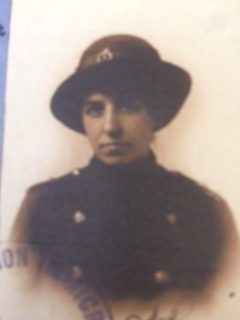Personal Details
Born: 25 July 1886 in Wybunbury, Cheshire and baptised on 20 August 1886 at Wybunbury Parish Church, Wybunbury, Cheshire.
Family: She was the youngest of six surviving children born to Charles Roper Whitton, an agent for cattle food and his wife Elizabeth Mary, nee Hewat. She did not marry.
Residence: In 1891 her family were living at Heathfield, Hatherton, Nantwich, Cheshire. By 1901 they had moved to 8 Pepper Street, Nantwich. No trace can be found of her in the 1911 Census but her parent`s address was 32 Edgeley Road, Whitchurch, Shropshire. She emigrated to the United States in 1913 and joined the Canadian Army Medical Corps in 1917 her address was given as 353 Bay Street, South Hamilton, Ontario, Canada but by June 1918 she gave an address of 316 Cherry Street, San Francisco, California. On her United States Naturalisation documents in 1941 she was said to have resided at 22 East 91st Street, New York City, New York. Before her death in 1969 she had been living in Santa Cruz, California.
Employment: She was a nurse.
Died: In December 1969 in Worthing, Sussex.
Military Details
Regiment: Canadian Expeditionary Force (Canadian Army Medical Corps.)
Rank: Nursing Sister
Service Number:
Date of Enlistment: 27 March 1917
Date of Discharge: 25 July 1919
Reason for Discharge: Demobilisation
Kathleen was awarded the Campaign medals (Victory and British War Medals)

The British War Medal (also known as 'Squeak') was a silver or bronze medal awarded to officers and men of the British and Imperial Forces who either entered a theatre of war or entered service overseas between 5th August 1914 and 11th November 1918 inclusive. This was later extended to services in Russia, Siberia and some other areas in 1919 and 1920. Approximately 6.5 million British War Medals were issued. Approximately 6.4 million of these were the silver versions of this medal. Around 110,000 of a bronze version were issued mainly to Chinese, Maltese and Indian Labour Corps. The front (obv or obverse) of the medal depicts the head of George V. The recipient's service number, rank, name and unit was impressed on the rim.
The Allied Victory Medal (also known as 'Wilfred') was issued by each of the allies. It was decided that each of the allies should each issue their own bronze victory medal with a similar design, similar equivalent wording and identical ribbon. The British medal was designed by W. McMillan. The front depicts a winged classical figure representing victory. Approximately 5.7 million victory medals were issued. Interestingly, eligibility for this medal was more restrictive and not everyone who received the British War Medal ('Squeak') also received the Victory Medal ('Wilfred'). However, in general, all recipients of 'Wilfred' also received 'Squeak' and all recipients of The 1914 Star or The 1914/1915 Star (also known as 'Pip') also received both 'Squeak' and 'Wilfred'. The recipient's service number, rank, name and unit was impressed on the rim.

